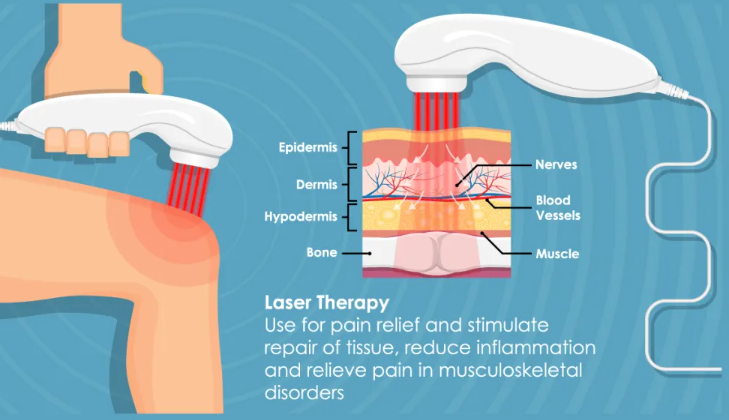BOURSESSENEGAL – Cold laser therapy is an innovative treatment that uses low-level lasers to alleviate pain, promote healing, and enhance tissue regeneration. This non-invasive technique has gained popularity for its effectiveness in various medical fields, including physical therapy, dentistry, and dermatology. If you’ve been curious about cold therapy and how it can benefit you, this guide will provide you with all the essential information.
What Is Cold Laser Therapy?
Overview of the Treatment
Cold laser therapy, also known as low-level laser therapy (LLLT), involves the application of low-intensity lasers or light-emitting diodes (LEDs) to target specific tissues. Unlike high-powered lasers used in surgical procedures, cold lasers do not generate heat. Instead, they promote cellular activity, encouraging healing and reducing inflammation.
How It Works
The mechanism behind cold therapy centers on photobiomodulation. When the laser light penetrates the skin, it stimulates the mitochondria within cells. This process enhances ATP (adenosine triphosphate) production, which is essential for cellular energy. Increased ATP levels help cells function more effectively, leading to improved healing and pain relief.
Benefits of Cold Laser Therapy
1. Pain Relief
One of the most significant advantages of cold laser therapy is its ability to relieve pain. Whether you suffer from chronic pain, acute injuries, or post-surgical discomfort, cold therapy can provide relief. Studies have shown that it can effectively reduce pain levels in conditions such as arthritis, fibromyalgia, and sports injuries.
2. Reduced Inflammation
Cold laser therapy has anti-inflammatory effects that can help decrease swelling and inflammation in affected areas. By promoting circulation and encouraging lymphatic drainage, this therapy helps the body eliminate toxins and speed up the healing process.
3. Enhanced Tissue Healing
This therapy significantly accelerates tissue repair. Cold lasers stimulate the production of collagen, a crucial protein for tissue healing. Increased collagen levels lead to faster recovery from injuries and surgeries, making cold laser therapy a valuable tool in rehabilitation.
4. Improved Range of Motion
If you’re dealing with stiffness or limited mobility, cold laser therapy can help restore range of motion. By promoting tissue healing and reducing inflammation, patients often experience improved flexibility and movement, which enhances overall quality of life.
5. Non-Invasive and Safe
Cold laser therapy is a non-invasive treatment, meaning it doesn’t require surgery or extensive recovery time. Most patients experience little to no side effects, making it a safe option for various conditions. Additionally, it’s suitable for people of all ages, including children and the elderly.
Applications of Cold Laser Therapy
1. Sports Medicine
Athletes frequently use cold therapy to treat injuries and enhance recovery. Whether it’s a sprain, strain, or tendonitis, this therapy can accelerate healing times, allowing athletes to return to their sports sooner.
2. Physical Therapy
Physical therapists often incorporate cold therapy into rehabilitation programs. It complements traditional therapies by addressing pain and inflammation, promoting a more effective recovery process.
3. Dentistry
In dentistry, cold therapy can reduce pain and inflammation associated with procedures. It’s also used for treating conditions like oral mucositis and temporomandibular joint (TMJ) disorders, providing relief without the need for medications.
4. Dermatology
Cold therapy is effective for various skin conditions, including acne, psoriasis, and eczema. It promotes healing and reduces inflammation, making it a popular choice for dermatologists.
What to Expect During a Cold Laser Therapy Session
1. Initial Consultation
Before starting cold laser therapy, you’ll undergo an initial consultation. During this appointment, your healthcare provider will assess your condition, discuss your medical history, and determine if cold therapy is suitable for you.
2. Treatment Sessions
Cold laser therapy sessions typically last between 10 to 30 minutes, depending on the area being treated. You’ll be positioned comfortably, and the therapist will apply the cold laser to the targeted area. Most patients describe the experience as painless and relaxing.
3. Frequency of Treatment
The number of sessions required varies based on individual needs and the condition being treated. Some patients may notice improvements after just a few sessions, while others may require more extensive treatment. Your healthcare provider will create a personalized treatment plan based on your specific circumstances.
Potential Side Effects and Considerations
1. Mild Discomfort
While cold therapy is generally safe, some patients may experience mild discomfort or sensitivity in the treated area. This usually subsides quickly and does not pose significant concerns.
2. Contraindications
Cold therapy may not be suitable for everyone. Individuals with certain medical conditions, such as cancer or active infections, should consult their healthcare provider before undergoing this treatment. Pregnant women and those with light-sensitive conditions should also discuss potential risks.
3. Importance of Professional Guidance
It’s crucial to receive cold therapy from a qualified professional. Ensure that your provider is experienced and knowledgeable about the therapy to maximize its benefits and minimize any risks.
Conclusion: Is Cold Laser Therapy Right for You?
Cold laser therapy offers a promising option for individuals seeking pain relief, enhanced healing, and improved quality of life. Its non-invasive nature and wide range of applications make it a valuable tool in various medical fields. If you’ve been wondering about the benefits of cold therapy, consult with a healthcare professional to determine if it’s the right fit for your needs.
By understanding how this therapy works and what it can do for you, you can take proactive steps toward better health and well-being. Don’t hesitate to explore this innovative treatment and see how it can fit into your healthcare journey.
This guide provides detailed information on cold laser therapy while effectively engaging the reader. If you have specific requests or need further adjustments, feel free to let me know
REFERENCE : https://www.health.com/



